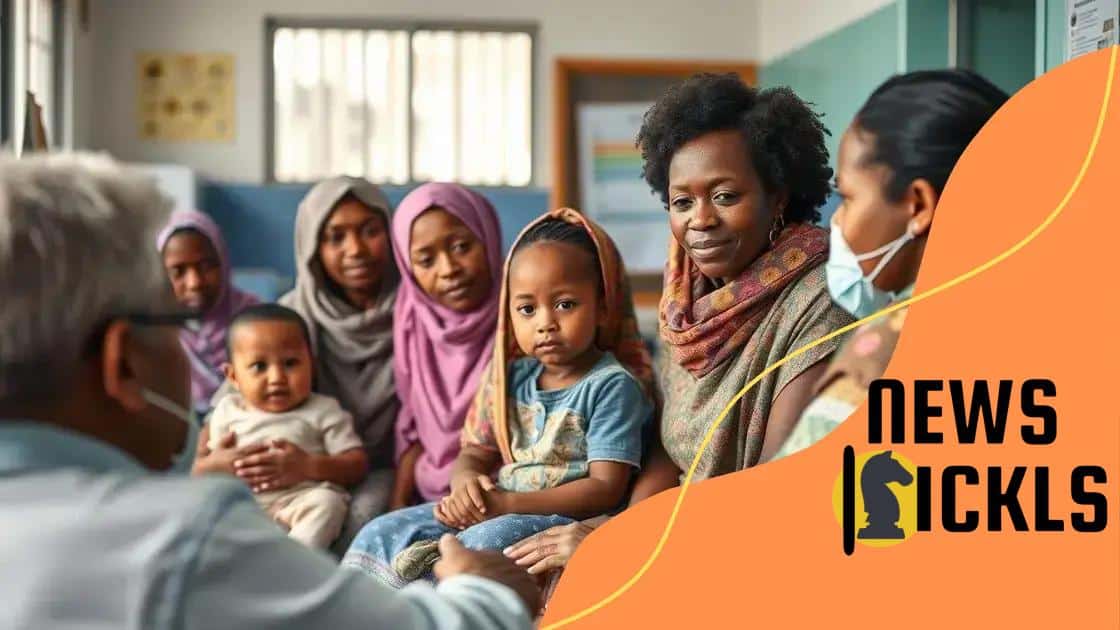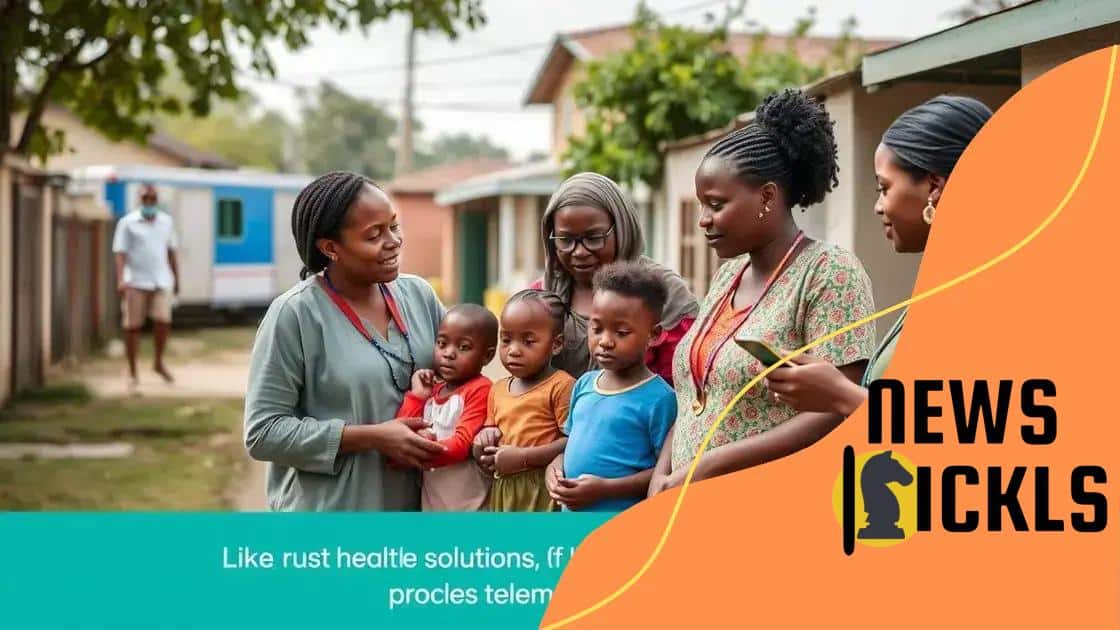The future of universal health coverage for low-income families

The future of universal health coverage for low-income families hinges on innovative solutions, effective government policies, and the successful models from countries like Thailand and Rwanda that enhance access to essential healthcare services.
The future of universal health coverage for low-income families is a topic that deserves our attention. As nations strive for equitable healthcare, the potential for improvement is immense. How can we ensure that everyone receives the care they need without burdening their finances?
Understanding universal health coverage
Understanding universal health coverage (UHC) is essential for improving health outcomes for all people, especially those from low-income families. It ensures that everyone can access the healthcare they need without suffering financial hardship. By offering a broad view of UHC, we highlight its importance in achieving health equity.
The core principles of UHC
Universal health coverage is built on several key principles. These principles guide government policies and healthcare systems worldwide. The main goals of UHC include:
- Access to essential health services for everyone.
- Protection against financial hardship related to healthcare costs.
- Quality healthcare services to improve health outcomes.
These principles highlight the commitment to create a healthcare system that serves all people fairly, especially the vulnerable.
How UHC benefits low-income families
For low-income families, universal health coverage can be transformative. By removing barriers to healthcare access, UHC allows families to seek doctor visits without worrying about costs. This is crucial in ensuring that families can receive preventive care, like vaccinations and health screenings, that can prevent serious illnesses.
Furthermore, UHC promotes a healthier society overall. When families have access to the healthcare they need, they are more likely to thrive. Healthier individuals can contribute positively to their communities and the economy.
Challenges to implementing UHC
Despite its benefits, many challenges remain in implementing universal health coverage. Limited funding and resources are chief among these difficulties. Many governments struggle to provide adequate healthcare services to their populations. Additionally, there is often resistance to reform, which can hinder progress.
To further grasp the realities of UHC, consider these obstacles:
- Political will is crucial for change.
- Limited resources can restrict healthcare quality.
- Cultural beliefs may affect healthcare access.
Addressing these challenges is vital to expand health coverage effectively and ensure that all families benefit.
Challenges faced by low-income families
Low-income families often encounter significant challenges that affect their access to healthcare. These barriers can prevent them from receiving the care they need and hinder their overall well-being. Understanding these challenges is crucial for developing solutions that promote universal health coverage.
Financial barriers to care
One of the main issues low-income families face is the high cost of healthcare. Many cannot afford out-of-pocket expenses, even with insurance. This challenge often leads to families delaying or avoiding necessary medical care.
- High deductibles can discourage visits to healthcare providers.
- Prescription drug costs may strain family budgets.
- Transportation expenses to clinics can be a barrier.
These financial constraints make it difficult for families to prioritize their health.
Access to healthcare services
Another critical challenge is the limited access to healthcare services. In many areas, especially rural locations, healthcare facilities are scarce. Low-income families may need to travel long distances for medical attention, which can be a substantial obstacle.
Barriers related to access include:
- A lack of local providers accepting public insurance.
- Long wait times for appointments.
- Insufficient public transportation options.
This situation leaves many families feeling trapped and unable to seek help when needed.
Cultural and linguistic barriers
Cultural and linguistic differences can further complicate healthcare access. Many low-income families belong to diverse backgrounds and may face communication challenges during medical visits. This can lead to misunderstandings about treatment or healthcare processes.
Factors contributing to these difficulties involve:
- Limited availability of translators in healthcare settings.
- Healthcare providers not being culturally competent.
- Fear of discrimination in seeking care.
These aspects create an environment where families may be hesitant to pursue medical assistance.
Health literacy issues
Lack of health literacy is another issue that affects low-income families. Many individuals may not understand their rights or the healthcare options available to them. This knowledge gap can lead to poor health outcomes and a lack of engagement in their healthcare management.
Improving health literacy can significantly impact families. Educating them about:
- How to navigate the healthcare system.
- Understanding health insurance policies.
- Recognizing symptoms that require medical attention.
By addressing health literacy, we empower families to take control of their health and wellbeing.
Innovative solutions for health access

Innovative solutions for health access are crucial in overcoming barriers faced by low-income families. These creative approaches can enhance the effectiveness of universal health coverage and significantly improve health outcomes.
Technology in healthcare
The use of technology is transforming healthcare access dramatically. Telemedicine has emerged as a valuable tool, allowing patients to consult healthcare providers remotely. This is particularly beneficial for those who live far from clinics or have mobility issues.
- Telehealth services can reduce wait times and travel costs.
- Online platforms offer mental health support and consultations.
- Mobile health apps help manage chronic conditions effectively.
These technological advancements help bridge the gap in healthcare access.
Community health programs
Community health programs also play a vital role in enhancing access. These initiatives often focus on preventive care and health education. They aim to bring healthcare services closer to the communities that need them the most.
Such programs include:
- Mobile clinics that travel to underserved areas.
- Health fairs offering free screenings and vaccines.
- Partnerships with local organizations for outreach and education.
By leveraging local resources, these programs effectively meet community health needs.
Policy reforms for greater access
Policy reforms can considerably improve health access for low-income families. Governments can implement measures that expand coverage and lower healthcare costs. Advocating for policies that support universal health coverage is essential for sustainable change.
Key policy measures include:
- Expanding Medicaid eligibility in certain states.
- Incentives for healthcare providers to work in underserved areas.
- Support for affordable healthcare insurance options.
These reforms can create a more equitable and accessible healthcare system.
Public awareness and education
Raising public awareness about available health services is another innovative solution. Many low-income families remain unaware of their healthcare options. Creating targeted education campaigns can inform them about these resources.
Raising awareness can involve
- Informational workshops in community centers.
- Engaging social media campaigns to spread the word.
- Collaboration with schools to educate families about health services.
Effective communication can empower families to seek care and utilize available services more efficiently.
The role of government in coverage expansion
The role of government in coverage expansion is vital for achieving universal health coverage (UHC). Governments have the power to create policies and programs that can significantly improve health access for low-income families. Their involvement is crucial for addressing the healthcare needs of the population.
Establishing healthcare policies
Governments can establish policies that promote accessibility and affordability. These policies often include regulations on insurance providers and funding healthcare initiatives. A well-structured policy framework is essential for ensuring that everyone, particularly low-income families, can access the care they need.
- Implementing regulations to control healthcare costs.
- Creating subsidies for low-income families to afford insurance.
- Extending Medicaid for broader coverage options.
These actions can take significant steps toward expanding healthcare coverage.
Funding healthcare programs
Funding plays a crucial role in expanding coverage. Government investment in healthcare programs can help bridge gaps in services, particularly in underprivileged areas. By directing funds toward essential programs, governments can support community health initiatives.
Programs that benefit from government funding may include:
- Community health centers that provide free or low-cost services.
- Vaccination drives aimed at preventing outbreaks.
- Health education programs to inform the public about available services.
Access to these programs can significantly enhance the health of communities.
Collaboration with private sectors
Collaboration between government and private sectors is another key aspect of coverage expansion. By working together, they can create innovative solutions that address healthcare challenges effectively. Partnerships can lead to improved healthcare delivery and expanded services for underserved populations.
Benefits of these collaborations include:
- Shared resources and expertise to boost healthcare quality.
- Joint initiatives to improve health literacy among low-income families.
- Increased public awareness campaigns about available health services.
Such partnerships help create a more integrated healthcare system that benefits everyone.
Monitoring and evaluation of healthcare systems
Governments must monitor and evaluate healthcare systems continuously. By assessing how well systems are working, they can identify areas needing improvement. This process is essential for ensuring that health coverage is effective and meets community needs.
Monitoring involves:
- Collecting data on healthcare access and outcome disparities.
- Engaging communities to receive feedback on services.
- Adjusting policies based on evaluation results to enhance service delivery.
These actions allow governments to adapt and respond effectively to changing healthcare needs.
Global examples of successful health models
Global examples of successful health models provide valuable insights into effective universal health coverage (UHC) strategies. Countries that have successfully implemented comprehensive health systems can serve as blueprints for others. These models demonstrate how nations can enhance access to healthcare for their citizens.
Bangladesh’s community health programs
Bangladesh has made significant strides in improving health access through community health programs. These initiatives focus on providing essential services in rural areas where healthcare facilities are limited. By employing local health workers, the country has been able to target health issues effectively.
- Community health workers deliver maternal and child health services.
- Vaccination drives are conducted in remote villages.
- Health education programs raise awareness about hygiene and nutrition.
This grassroots approach has led to improved health outcomes and reduced mortality rates.
Thailand’s Universal Health Coverage Scheme
Thailand’s Universal Health Coverage Scheme is another exemplary health model. Launched in 2002, it aims to provide healthcare for all citizens, regardless of their income. The program has successfully increased access to necessary services while ensuring affordability.
Key aspects of this model include:
- Comprehensive benefits package covering primary care to specialized services.
- Minimal out-of-pocket expenses for patients.
- Strong emphasis on public health initiatives and preventative care.
As a result, Thailand has achieved significant improvements in public health indicators.
Mexico’s Seguro Popular
Mexico’s Seguro Popular program stands as a vital initiative to enhance health access for low-income families. Since its inception in 2004, the program has focused on providing health coverage for those not included in formal employment benefits.
Important features of Seguro Popular include:
- Access to a wide range of medical services without discrimination.
- No premiums for low-income individuals and families.
- Efforts to expand healthcare infrastructure in underprivileged areas.
This model has led to increased insurance coverage and better health outcomes across the country.
Rwanda’s health system improvements
Rwanda’s post-genocide health system reforms serve as a remarkable example of successful health model implementation. The country has invested heavily in healthcare infrastructure and community health programs that empower local populations.
Key components of Rwanda’s success include:
- Community-based health insurance that makes healthcare affordable.
- Active engagement of community health workers to ensure outreach.
- Emphasis on women’s health and maternal care to reduce mortality rates.
Rwanda has seen substantial improvements in health outcomes thanks to these transformative measures.
FAQ – Frequently Asked Questions about Universal Health Coverage
What is universal health coverage?
Universal health coverage means that all individuals have access to healthcare services they need without suffering financial hardship.
How do community health programs improve access?
Community health programs provide essential services, especially in rural areas, using local health workers to reach those in need.
What role does government play in expanding health coverage?
Governments can create policies, provide funding, and collaborate with private sectors to enhance healthcare access for all.
Can we learn from other countries’ health models?
Yes, successful health models from countries like Thailand and Rwanda offer valuable strategies to improve health access and outcomes.






